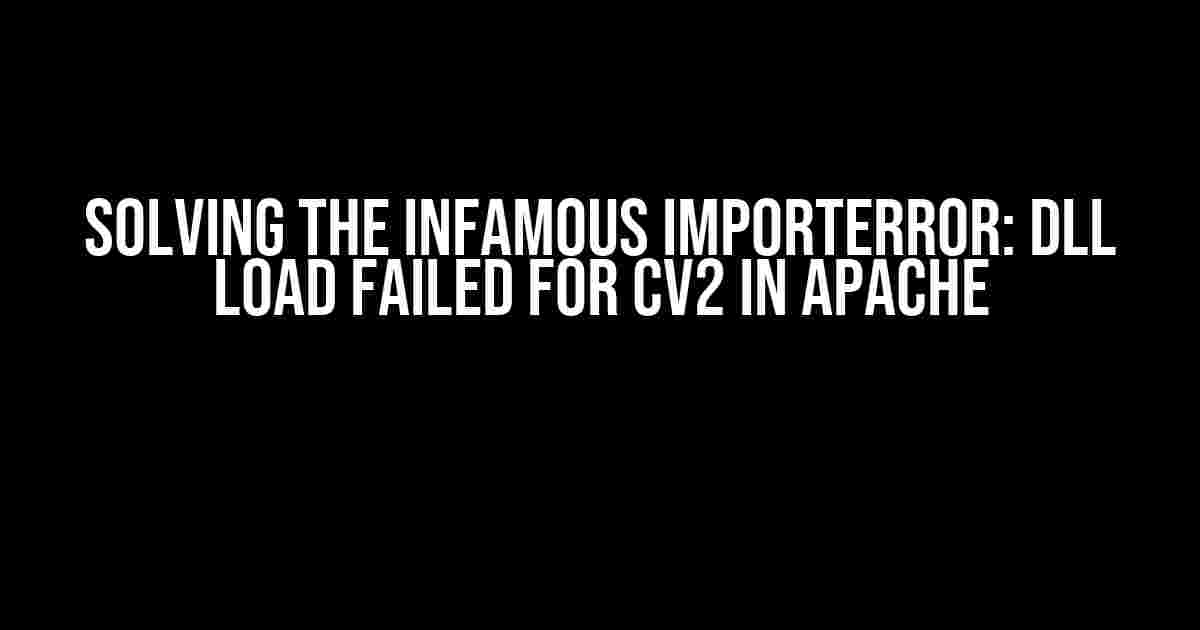Are you tired of encountering the pesky ImportError error when trying to run your project on Apache, only to be greeted with the frustrating message “DLL load failed while importing cv2”? You’re not alone! This error has plagued many a developer, leaving them scratching their heads and wondering why their code won’t just work already!
The Culprit: cv2 and Apache’s Conflict
Before we dive into the solution, let’s understand the root cause of this issue. The ImportError occurs because OpenCV (cv2) relies on certain DLL files to function properly. However, when running your project on Apache, these DLL files might not be accessible or might be conflicting with other libraries. This conflict arises from the way Apache handles dependencies and loads libraries.
Theories and Suspects
There are a few theories behind this error, including:
- Missing or Corrupted DLL Files: It’s possible that the required DLL files for OpenCV are missing or corrupted, preventing Apache from loading them successfully.
- Library Conflicts: Other libraries or dependencies might be conflicting with the OpenCV DLL files, leading to the ImportError.
- Absolute Path Issues: Apache might be having trouble finding the required DLL files due to incorrect or relative path configurations.
Solution Time!
Fear not, dear developer! We’ll tackle this error together, step by step. Follow these instructions to resolve the ImportError and get your project up and running on Apache:
Step 1: Check Your OpenCV Installation
First, ensure you have OpenCV installed correctly on your system. You can do this by:
- Opening a new Python terminal or command prompt
- Typing `pip install opencv-python` (or `pip3 install opencv-python` for Python 3)
- Verifying the installation by running `import cv2` in your Python environment
Step 2: Verify Apache and Python Versions
Next, confirm that your Apache and Python versions are compatible:
- Check your Apache version by running `httpd -v` in your command prompt
- Verify your Python version by running `python –version` (or `python3 –version` for Python 3)
- Ensure that your Apache version is compatible with your Python version
Step 3: Update Your Python Script
Modify your Python script to include the following code before importing cv2:
import os
os.environ['PATH'] = r'C:\path\to\opencv\bin;' + os.environ['PATH']
import cv2
Replace `C:\path\to\opencv\bin` with the actual path to your OpenCV installation’s bin folder.
Step 4: Configure Apache
Update your Apache configuration file (usually `httpd.conf` or `apache2.conf`) to include the following lines:
<Directory /path/to/your/project>
<Files "your_python_script.py">
SetEnv PYTHONPATH /path/to/your/python/installation:/path/to/opencv/installation/python
</Files>
</Directory>
Replace `your_python_script.py` with the name of your Python script, and `/path/to/your/project` with the directory containing your project. Also, update the `PYTHONPATH` environment variable to include the paths to your Python installation and OpenCV installation’s Python folder.
Step 5: Restart Apache and Run Your Script
Restart your Apache server to apply the configuration changes:
- Run `service httpd restart` (or `service apache2 restart` for Apache 2)
- Run your Python script using Apache
Troubleshooting Tips
If you still encounter issues, try the following:
- Check for DLL File Corruption: Ensure that the DLL files in your OpenCV installation’s bin folder are not corrupted. Try reinstalling OpenCV or replacing the DLL files with fresh copies.
- Verify Library Conflicts: Check for any conflicting libraries or dependencies that might be causing the issue. Try removing or updating conflicting libraries.
- Absolute Path Debugging: Verify that the absolute paths in your Apache configuration file are correct and point to the correct locations.
Conclusion
Voilà! With these steps, you should be able to resolve the infamous ImportError error and get your project running smoothly on Apache. Remember to be patient, and don’t hesitate to try different approaches until you find the solution that works for you.
By following this comprehensive guide, you’ve taken a major step in conquering the cv2 ImportError error. Pat yourself on the back, take a deep breath, and get back to coding like a pro!
| Common Issues | Solutions |
|---|---|
| Missing or Corrupted DLL Files | Reinstall OpenCV or replace DLL files |
| Library Conflicts | Check for conflicts, remove or update libraries |
| Absolute Path Issues | Verify absolute paths in Apache configuration |
Remember, the key to resolving this error lies in understanding the underlying causes and taking a methodical approach to troubleshooting. Happy coding, and don’t let the ImportError get in your way!
Frequently Asked Question
Stuck with the infamous “DLL load failed” error while importing OpenCV in your Apache project? Don’t worry, we’ve got you covered! Here are some frequently asked questions and answers to help you troubleshoot and resolve the issue.
Q1: What is the “DLL load failed” error, and why does it occur?
The “DLL load failed” error occurs when Python tries to import the OpenCV library (cv2) but can’t find the required DLL files. This usually happens when the OpenCV installation is incomplete or when the system’s PATH environment variable is not set correctly.
Q2: How can I check if OpenCV is installed correctly?
You can check if OpenCV is installed correctly by opening a new Python console and typing `import cv2`. If OpenCV is installed correctly, this command should not throw any errors. You can also check the OpenCV installation directory to ensure that the required DLL files (like opencv_world440.dll) are present.
Q3: What is the role of the PATH environment variable in resolving the “DLL load failed” error?
The PATH environment variable tells the system where to look for the required DLL files. When you install OpenCV, the installation directory should be added to the system’s PATH environment variable. If this is not done, Python won’t be able to find the required DLL files, resulting in the “DLL load failed” error.
Q4: How can I add the OpenCV installation directory to the system’s PATH environment variable?
You can add the OpenCV installation directory to the system’s PATH environment variable by following these steps: Right-click on “This PC” (or “Computer” in older Windows versions) > Properties > Advanced system settings > Environment Variables > System Variables > Path > Edit > New > Browse to the OpenCV installation directory (usually C:\Python3x\Lib\site-packages\cv2) > OK. Restart your system and try importing OpenCV again.
Q5: Are there any other potential solutions to the “DLL load failed” error?
Yes, there are other potential solutions to the “DLL load failed” error. You can try reinstalling OpenCV, checking for any conflicts with other installed packages, or using a virtual environment to isolate the OpenCV installation. You can also try copying the required DLL files to the directory where your Python script is running.




